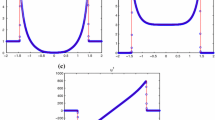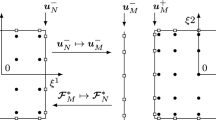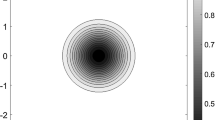Abstract
Compressible Euler equations describing the motion of compressible inviscid fluids are typically solved by means of low-order finite volume (FVM) or finite element (FEM) methods. A promising recent alternative to these low-order methods is the higher-order discontinuous Galerkin (\(hp\)-DG) method (Schnepp and Weiland, J Comput Appl Math 236:4909–4924, 2012; Schnepp and Weiland, Radio Science, vol 46, RS0E03, 2011) that combines the stability of FVM with excellent approximation properties of higher-order FEM. This paper presents a novel \(hp\)-adaptive algorithm for the \(hp\)-DG method which is based on meshes that change dynamically in time. The algorithm reduces the order of the approximation on shocks and keeps higher-order elements where the approximation is smooth, which leads to an efficient discretization of the time-dependent problem. The method is described and numerical examples are presented.

















Similar content being viewed by others
References
Demkowicz L, Rachowicz W, Devloo P ( 2001) A fully automatic \(hp\)-adaptivity. TICAM Report No. 01–28, University of Texas at Austin
Dubcova L, Solin P, Cerveny J, Kus P (2010) Space and time adaptive two-mesh hp-FEM for transient microwave heating problems. Electromagnetics 30(1):23–40
Dolejsi V, Feistauer M (2004) A semi-implicit discontinuous Gelerkin finite element method for the numerical solution of inviscid compressible flow. J Comput Phys 198:727–746
Dolejsi V, Feistauer M, Schwab C (2003) On some aspects of the discontinuous Galerkin finite element method for conservation laws. Math Comput Simul 6:333–346
Feistauer M (1993) Mathematical methods in fluid dynamics. Longman Scientific & Technical, Harlow
Feistauer M, Felcman J, Straskraba I (2003) Mathematical and computational methods for compressible flow. Oxford University Press, Oxford
Feistauer M, Kucera V (2008) A new technique for the numerical solution of the compressible Euler equations with arbitrary Mach numbers. In: Proceedings of the conference hyperbolic problems: theory, numerics and applications. Springer, Berlin, pp 523–531
Hermes, an open source C++ library for rapid development of adaptive \(hp\)-FEM and \(hp\)-DG codes with emphasis on nonlinear, time-dependent, multiphysics coupled problems http://hpfem.org/hermes
Kuzmin D (2010) A vertex-based hierarchical slope limiter for p-adaptive discontinuous Galerkin methods. J Comput Appl Math 233(12):3077–3085
Lube G (1994) Stabilized Galerkin finite element methods for convection dominated and incompressible flow problems. In: Num. Anal. and Math. Model. vol 29. Banach Center publications, Warszawa
Schnepp SM, Weiland T (2012) Efficient large scale electromagnetic simulations using dynamically adapted meshes with the discontinuous Galerkin method. J Comput Appl Math 236:4909–4924
Schnepp SM, Weiland T (2011) Discontinuous Galerkin methods with transient hp-adaptation. Radio Science, vol 46, RS0E03
Solin P, Cerveny J, Dubcova L, Andrs D (2010) Monolithic discretization of linear thermoelasticity problems via adaptive multimesh hp-FEM. J Comput Appl Math 234:2350–2357
Solin P, Dubcova L, Kruis J (2010) Adaptive hp-FEM with dynamical meshes for transient heat and moisture transfer problems. J Comput Appl Math 233:3103–3112
Tezduyar TE, Senga M (2006) Stabilization and shock-capturing parameters in SUPG formulation of compressible flows. Comput Methods Appl Mech Eng 195:1621–1632
Acknowledgments
This research was supported by the following sources: 1. The European Regional Development Fund and the Ministry of Education, Youth and Sports of the Czech Republic under the Regional Innovation Centre for Electrical Engineering (RICE), project No. CZ.1.05/2.1.00/03.0094 2. Grant No. P105/10/1682 of the Grant Agency of the Czech Republic 3. Subcontract No. 00089911 of Battelle Energy Alliance (U.S. Department of Energy intermediary) 4. SGS (Studentska Grantova Soutez) grant number SGS-2012-039
Author information
Authors and Affiliations
Corresponding author
Rights and permissions
About this article
Cite this article
Korous, L., Solin, P. An adaptive \(hp\)-DG method with dynamically-changing meshes for non-stationary compressible Euler equations. Computing 95 (Suppl 1), 425–444 (2013). https://doi.org/10.1007/s00607-012-0257-1
Received:
Accepted:
Published:
Issue Date:
DOI: https://doi.org/10.1007/s00607-012-0257-1
Keywords
- Numerical simulation
- Finite element method
- Euler equations
- \(hp\)-adaptivity
- Discontinuous Galerkin method
- Automatic adaptivity
- Dynamically changing meshes




